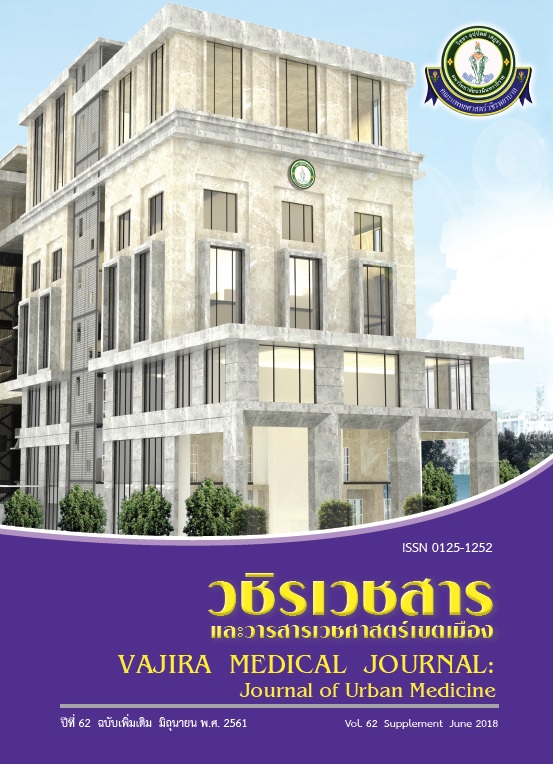Comparison of Stool Examination Techniques for Detection of Parasitic Infections
Main Article Content
Abstract
Objective: To compare the diagnostic efficacy of various stool examination techniques for detection of parasitic infections.
Methods: Using a cross-sectional study, a total of 422 achieved fecal samples randomly selected from stool sample blank of Department of Parasitology, Phramongkutklao College of Medicine, Bangkok, Thailand, were used for a comparison of stool examination techniques. All stool samples were mixed thoroughly and divided into four portions for examination of parasitic infection using simple smear, formalin-ethyl acetate concentration technique (FECT), Kato technique and fecal parasite concentrator kit. The diagnostic efficacy of each technique was evaluated for the prevalence, sensitivity and negative predictive value.
Results: FECT provided the highest sensitivity for parasite infection (80.2%) and Opisthorchis viverrini infection (95.0%) followed by Kato technique, fecal parasite concentrator kit and direct simple smear technique. The fecal parasite concentrator kit showed the higher sensitivity (30.2%) than the simple smear technique (24.5%).
Conclusion: FECT showed the highest diagnostic efficacy among the four methods. Replacement of fecal concentrator kit for FECT and Kato technique is not recommended for detecting parasitic infections.
Downloads
Article Details
References
2. Alum A, Rubino JR, Ijaz MK. The global war against intestinal parasites should we use a holistic approach. Int J Infect Dis. 2010; 14(9):e732-8.
3. Yanola J, Nachaiwieng W, Duangmano S, Prasannarong M, Somboon P, Pornprasert S. Current prevalence of intestinal parasitic infections and their impact on hematological and nutritional status among Karen hill tribe children in Omkoi District, Chiang Mai Province, Thailand. Acta Trop. 2018; 180: 1-6.
4. Kim CS, Smith JF, Suwannatrai A, Echaubard P, Wilcox B, Kaewkes S, et al. Role of socio-cultural and economic factors in cyprinid fish distribution networks and consumption in Lawa Lake region, Northeast Thailand: Novel perspectives on Opisthorchis viverrini transmission dynamics. Acta Trop. 2017; 170: 85-94.
5. Nuchprayoon S, Siriyasatien P, Kraivichian K, Porksakorn C, Nuchprayoon I. Prevalence of parasitic infections among Thai patients at the King Chulalongkorn Memorial Hospital, Bangkok, Thailand. J Med Assoc Thai. 2002; 85 Suppl 1:S415-23.
6. Neimeister R, Logan AL, Egleton JH, Kleger B. Evaluation of direct wet mount parasitological examination of preserved fecal specimens. J Clin Microbiol. 1990; 28(5): 1082-4.
7. Pinlaor S, Hiraku Y, Ma N, Yongvanit P, Semba R, Oikawa S, et al. Mechanism of NO-mediated oxidative and nitrative DNA damage in hamsters infected with Opisthorchis viverrini: a model of inflammation-mediated carcinogenesis. Nitric Oxide. 2004; 11(2): 175-83.
8. Sripa B, Pairojkul C. Cholangiocarcinoma: lessons from Thailand. Curr Opin Gastroenterol. 2008; 24(3): 349-56.
9. Funk AL, Boisson S, Clasen T, Ensink JH. Comparison of Kato-Katz, ethyl-acetate sedimentation, and Midi Parasep(R) in the diagnosis of hookworm, Ascaris and Trichuris infections in the context of an evaluation of rural sanitation in India. Acta Trop. 2013; 126(3): 265-8.
10. Knopp S, Mgeni AF, Khamis IS, Steinmann P, Stothard JR, Rollinson D, et al. Diagnosis of soil-transmitted helminths in the era of preventive chemotherapy: effect of multiple stool sampling
11. Becker SL, Lohourignon LK, Speich B, Rinaldi L, Knopp S, N'Goran E K, et al. Comparison of the Flotac-400 dual technique and the formalin-ether concentration technique for diagnosis of human intestinal protozoon infection. J Clin Microbiol. 2011; 49(6): 2183-90.
12. Utzinger J, Botero-Kleiven S, Castelli F, Chiodini PL, Edwards H, Kohler N, et al. Microscopic diagnosis of sodium acetate-acetic acid-formalinfixed stool samples for helminths and intestinal protozoa: a comparison among European reference laboratories. Clin Microbiol Infect. 2010; 16(3): 267-73.
13. Kaewpitoon SJ, Rujirakul R, Tongtawee T, Matrakul L, Panpimanmas S, Wakkuwattapong P, et al. Detection of the Carcinogenic Liver Fluke Opisthorchis viverrini Using a Mini Parasep SF Faecal Parasite Concentrator. Asian Pac J Cancer Prev. 2016; 17(1): 373-6.
14. Beaver PC. The standardization of fecal smears for estimating egg production and worm burden. J Parasitol. 1950; 36(5): 451-6.
15. Kato K, Miura M. Comparative examinations. Japanese J Parasitol. 1954; 3: 35.
16. Katz N, Chaves A, Pellegrino J. A simple device for quantitative stool thick-smear technique in Schistosomiasis mansoni. Rev Inst Med Trop Sao Paulo. 1972; 14(6): 397-400.
17. Truant AL, Elliott SH, Kelly MT, Smith JH. Comparison of formalin-ethyl ether sedimentation, formalin-ethyl acetate sedimentation, and zinc sulfate flotation techniques for detection of intestinal parasites. J Clin Microbiol. 1981; 13(5): 882-4.
18. Laoprom N, Laithavewat L, Kopolrat K, Kiatsopit N, Kaewkes S, Chantalux S, et al. Evaluation of a Commercial Stool Concentrator Kit Compared to Direct Smear and Formalin-Ethyl Acetate Concentration Methods for Diagnosis of Parasitic Infection with Special Reference to Opisthorchis Viverrini Sensu Lato in Thailand. Southeast Asian J Trop Med Public Health. 2016; 47(5): 890-900.
19. Suwannahitatorn P, Klomjit S, Naaglor T, Taamasri P, Rangsin R, Leelayoova S, et al. A follow-up study of Opisthorchis viverrini infection after the implementation of control program in a rural community, central Thailand. Parasit Vectors. 2013; 6: 188.
20. Endris M, Tekeste Z, Lemma W, Kassu A. Comparison of the Kato-Katz, Wet Mount, and Formol-Ether Concentration Diagnostic Techniques for Intestinal Helminth Infections in Ethiopia. ISRN Parasito.l 2013; 2013: 180439.
21. Adugna S, Kebede T, Mekonnen Z, Degarege A, Liang S, Erko B. Diagnostic performance of Mini Parasep(R) solvent-free faecal parasite concentrator relative to Kato-Katz and McMaster for the diagnosis of intestinal parasitic infections. Trans R Soc Trop Med Hyg. 2017; 111(12): 572-8.
22. Glinz D, Silue KD, Knopp S, Lohourignon LK, Yao KP, Steinmann P, et al. Comparing diagnostic accuracy of Kato-Katz, Koga agar plate, etherconcentration, and FLOTAC for Schistosoma mansoni and soil-transmitted helminths. PLoS Negl Trop Dis. 2010; 4(7): e754.
23. Saez AC, Manser MM, Andrews N, Chiodini PL. Comparison between the Midi Parasep and Midi Parasep Solvent Free (SF) faecal parasite concentrators. J Clin Pathol. 2011; 64(10): 901-4.


